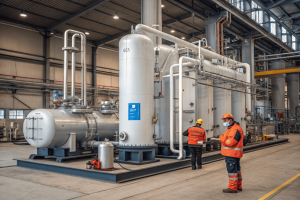Why is CO₂ recovery critical for achieving a net-zero goal in the cement and steel industries?
•
Why is CO₂ recovery critical for achieving a net-zero goal in the cement and steel industries?
Your cement or steel plant has emissions baked into its core chemistry. Net-zero goals seem impossible. CO₂ recovery offers the only path to capture these unavoidable process emissions at the source.
CO₂ recovery is critical because a large portion of emissions in these industries comes from chemical processes themselves, not just burning fuel. Only direct capture can intercept this "process CO₂," making it essential for reaching net-zero.
For years, I've worked with managers in heavy industry. They have optimized every part of their process for efficiency. But they all hit the same wall. The chemical reaction to make cement from limestone, or to turn iron ore into iron, releases massive amounts of CO₂. This isn't an inefficiency; it's part of the fundamental recipe. This is why when they come to FTL Machine, our conversation quickly moves beyond simple fuel savings. We start discussing how to deploy a technology that can fundamentally decarbonize their core business.
What are the specific requirements for CO₂ purity when used in the food and beverage industry (e.g., carbonation)?
You've captured CO₂, but you want to sell it for beverage carbonation. Impurities can ruin flavor and pose health risks. You need specialized purification systems to meet strict food-grade standards.
Food-grade CO₂ requires 99.9% purity and must meet strict industry standards, such as those from the ISBT. It demands extremely low levels of specific contaminants like sulfur compounds and hydrocarbons to guarantee safety, taste, and quality for consumers.

I remember a project with a brewery client. They were considering capturing their fermentation CO₂, but they were worried about quality. A single batch of beer tainted with an off-flavor from impure CO₂ could mean a product recall and serious damage to their brand. This is a common concern. Just because your raw CO₂ stream is captured doesn't mean it's ready to go into a soda or beer. The journey from industrial flue gas to a refreshing, bubbly drink requires a very specific and rigorous purification process.
Beyond the 99.9% Purity Mark
Achieving a 99.9% purity level is just the first step. The real challenge is removing trace contaminants that can affect taste, smell, and human health, even in parts-per-million (ppm) or parts-per-billion (ppb) concentrations.
Our systems at FTL Machine are designed with this in mind. We use a multi-stage purification train. This typically includes:
- Compression and Dehydration: To remove water.
- Activated Carbon Beds: These act like powerful sponges, adsorbing a wide range of organic compounds like hydrocarbons.
- Specialized Polishing Filters: These target specific problem-compounds, like sulfur, that cause the most significant issues.
Each stage is engineered to remove a different class of impurities, ensuring the final product is not just pure, but safe and tasteless.
| Contaminant | Typical Limit (ISBT) | Effect on Beverage |
|---|---|---|
| Sulfur (H₂S) | < 0.1 ppm | Unpleasant rotten egg smell and taste. |
| Benzene | < 0.02 ppm | A known carcinogen, a major safety risk. |
| Acetaldehyde | < 0.2 ppm | Creates an undesirable fruity or cidery off-flavor. |
| Oxygen (O₂) | < 20 ppm | Promotes oxidation, reducing product shelf life. |
How does the variable CO₂ concentration in industrial flue gas (e.g., from an incinerator vs. a brewery) impact system design?
You have a unique flue gas stream but assume a standard capture system will work. A mismatched system is inefficient and costly, failing to meet your goals. Your system must be precisely engineered for your specific CO₂ concentration.
Variable CO₂ concentration directly impacts system scale. A high-concentration source like a brewery fermenter needs a simpler design. A dilute source like an incinerator (5-10% CO₂) requires a much larger absorber and more energy to capture the same amount of CO₂.

I've designed capture systems for a huge variety of sources, and no two are exactly alike. One week, I might be working on a design for a brewery where the CO₂ coming off the fermenters is nearly 100% pure. The next week, I could be tackling the flue gas from a municipal waste incinerator, where the CO₂ is diluted down to less than 8% and mixed with all sorts of other gases. You simply cannot use the same design for both. The physics and economics are completely different.
Engineering for Dilution
The CO₂ concentration, or partial pressure, is one of the most important factors in our design process. A lower concentration makes it much harder for our capture solvent to "find" and grab the CO₂ molecules.
To overcome this, we have to make adjustments:
- Larger Absorber Tower: For dilute streams, we need a taller and wider absorber tower. This increases the contact time between the flue gas and the solvent, giving the solvent more opportunity to absorb the CO₂.
- Higher Solvent Flow Rate: We must circulate a larger volume of amine solvent to capture the same amount of CO₂ from a dilute gas stream. This requires larger pumps and more energy.
This is why a capture plant for a dilute source is significantly larger and more expensive to build and operate than one for a concentrated source.
| Flue Gas Source | Typical CO₂ % | Key Design Consideration |
|---|---|---|
| Brewery Fermentation | ~100% | Small-scale; focus is on purification and buffer storage. |
| Natural Gas Boiler | 8-10% | Large absorber, high solvent circulation, high energy use. |
| Waste Incinerator | 5-10% | Very large absorber, plus extensive pre-treatment for pollutants. |
| Cement Kiln | 15-30% | High concentration helps, but needs robust dust removal first. |
Describe the role of CO₂ capture in the production of low-carbon hydrogen (blue hydrogen).
You are exploring the growing hydrogen economy. You hear about "blue hydrogen" and wonder how it achieves its low-carbon status. The answer lies in combining a traditional process with modern capture technology.
CO₂ capture is the key technology that differentiates "blue hydrogen" from "gray hydrogen." It captures the large volume of CO₂ produced during the Steam Methane Reforming (SMR) process, preventing it from being released into the atmosphere.

I've seen a huge increase in inquiries about projects related to blue hydrogen. The most common way to make hydrogen today is a process called Steam Methane Reforming (SMR). You react natural gas (methane) with steam to produce hydrogen and CO₂. For decades, that CO₂ was just vented. This is what we now call "gray hydrogen." Blue hydrogen uses the exact same SMR process but adds one critical step: it captures that CO₂. This is where my team's work becomes essential.
Turning Gray Hydrogen Blue
The production of blue hydrogen is a perfect example of integrating CO₂ capture into an existing, well-understood industrial process to dramatically lower its carbon footprint.
The stream of gas that comes out of the SMR process is ideal for carbon capture. It's at a relatively high pressure and has a high concentration of CO₂, typically in the range of 15-25%. This is a sweet spot for capture technology.
- High Concentration: The high CO₂ percentage means the separation process is more efficient. We can use smaller absorber columns and less solvent compared to capturing from a dilute power plant flue gas. This reduces both the capital cost and the energy penalty of the capture unit.
- High Pressure: The gas is already pressurized, which reduces the energy needed for some of the downstream processing steps.
The captured CO₂ must then be transported and permanently stored underground, completing the "blue" hydrogen production chain. By integrating our CO₂ recovery systems, a traditional hydrogen plant can become a producer of a valuable low-carbon fuel. This allows industries to use clean-burning hydrogen without the massive carbon footprint of gray hydrogen.
Conclusion
CO₂ recovery is essential for net-zero in cement and steel due to their process emissions. The technology is flexible, meeting strict purity needs for food-grade CO₂ and enabling blue hydrogen production.
You may also be interested in:

Why is CO₂ recovery technology gaining popularity worldwide?
Why is CO₂ recovery technology gaining popularity worldwide? You see headlines about carbon capture everywhere. But you wonder if it's
Read more
How is a CO₂ recovery system designed to fit different industries?
How is a CO₂ recovery system designed to fit different industries? You're under pressure to implement a CO₂ recovery solution.
Read more
How energy-efficient are today’s CO₂ recovery technologies?
How energy-efficient are today’s CO₂ recovery technologies? You want to recover CO₂, but you fear that high electricity bills will
Read more